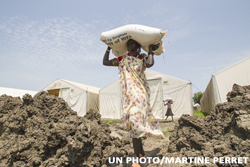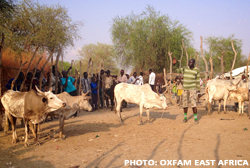
Editor's Note: This blog post was written by Enough Project Intern Faith Hornor.
On October 22, 2015, the Food and Agriculture Organization of the United Nations (FAO), the United Nations International Children’s Emergency Fund (UNICEF), and the World Food Programme (WFP) released a joint statement on the impending famine in South Sudan stating, “At least 30,000 people are living in extreme conditions and are facing starvation and death.” Despite the recently signed peace agreement, South Sudan faces a Phase Four level food emergency, which occurs when more than fifteen percent of the population suffers acute malnutrition, an increasing number of people are dying from starvation, and the average diet is limited to two or three food groups.
The food emergency is a result of external and internal factors. Externally, the effects of El Niño, which in the beginning of the planting season seemed promising, have taken a turn for the worse. Rainfall deficits occurred in July through September, and higher-then-average rainfall, which could result in floods, is predicted for the start of 2016. El Niño conditions have most impacted Upper Nile, Jonglei, and Unity States, where many people living in these areas are now without a source of income and face rising food prices. Furthermore, the continuation of conflict and a lack of infrastructure have resulted in international food agencies being limited in their means to access remote areas. The Greater Upper Nile area, which has been greatly affected by the ongoing conflict, has been particularly hard to access. Recently, the WFP reached remote villages in the Upper Nile State via airdrops, but many people, mostly women, children, and the elderly, continue to face high levels of malnutrition and are surviving by scavenging for food.
An interview with a South Sudanese citizen, Joseph,* revealed that gathering food “from the bush” is not uncommon even during peaceful times. What has changed is that, in the past, gathering was limited to seasonal food, but now people are forced to eat whatever they can find.
Issues concerning food availability are also persistent in United Nations Protection of Civilians (PoC) camps and informal Internally Displaced Person (IDP) sites throughout the country, where it has become increasingly unsafe for women to leave the camps for fear of violence, including rape and armed attack. With persistent conflict and increased local crime, gunfire is common and women are targets for assault. The decreasing level of safety combined with the underfunding of relief agencies leave families with limited options to meet even basic nutritional needs. While airdrops typically provide a two-week food supply, food within the camps can vary depending on stockpiles and the ability of officials to transport and receive shipments.
This food insecurity crisis is particularly disheartening considering the culture of food in South Sudan. Joseph explained how “the current situation [in South Sudan] has interrupted everything” including food culture. He discussed how farming used to be the main employment for South Sudanese. People often grew their own food, ate on a seasonal basis, and “used to celebrate harvest season.” Harvest celebrations, according to Joseph, were a time when communities would gather together to eat and drink and to be grateful for a successful season. It also provided a venue to discuss issues that could be resolved via communal action and input.
Harvests surrounded main South Sudanese exports such as sorghum, which is also a staple in the South Sudanese diet. The grain can be cooked and eaten alone, turned into stews, and ground into flour and used to make a traditional South Sudanese flatbread called kisra. Other diet staples vary by region and culture.
Throughout Western, Eastern, and Central Equatoria, agro-pastoral livelihoods are common. Combining livestock and agriculture provides consistent income throughout the seasons. This lifestyle is especially prevalent in the floodplain communities of Jonglei State where agriculture is the focus during the wet season and livestock during the rest of the year.
 Cattle is abundant with there being more cattle than people in the entirety of South Sudan.[1] Cow and goat milk are commonly consumed and some groups utilize all parts of livestock when it is slaughtered. Using cattle for meat consumption, however, is often a last resort. Instead, cattle works as a form of currency and resembles personal wealth and status. Moreover, ownership of cattle is a primary factor in a male’s ability to marry.
Cattle is abundant with there being more cattle than people in the entirety of South Sudan.[1] Cow and goat milk are commonly consumed and some groups utilize all parts of livestock when it is slaughtered. Using cattle for meat consumption, however, is often a last resort. Instead, cattle works as a form of currency and resembles personal wealth and status. Moreover, ownership of cattle is a primary factor in a male’s ability to marry.
Persistent violence has made it hard for farmers to remain in one village for a full season. As a result, harvest cycles are disrupted across the country. The inability of farmers and others to maintain stable lifestyles has increased reliance on imported food aid, often from Uganda, and has changed food preferences. Joseph believes that once the country stabilizes and refugees are able to return, food will become “a mixture of different cultures,” because IDPs and refugees will bring their new preferences while rural villagers will maintain past traditions.
South Sudanese generally eat two meals a day and a sweet hibiscus tea, karkade, is consumed throughout. Tea and tea spices commonly grow inside the home instead of being bought. Coffee, as a South Sudanese export, is also consumed.
With limited to no access to markets and electricity, the process that goes into daily food preparations becomes a full time job. Typically, women spend most of their days cooking. The process of gathering the water, food, and ignition oil can be lengthy especially in remote villages. Traditionally, ignition oil comes from the left over fat of the most recent meal, but processed oil has become more typical. Once preparations are finished, the children eat together from the same bowl. Adults often eat after the children go to sleep, and men and women eat separately. Mealtime practices can vary by region and family preference. When Joseph lived with his extended family, they would eat together around a table. It is now increasingly common for food to be served individually on plates and eaten separately.
Throughout the turmoil of the country, Joseph still returns to his favorite meal of cooked beans, known as wele wele, and eats it whenever he returns to South Sudan. This connection between food and home shows that food is not only essential to life, but also carries history, culture, and memory that is often lost behind stories of strife and conflict. Despite the heinous acts that many have borne witness to in South Sudan, it is important to recognize the beautiful culture that South Sudanese citizens and humanitarian organizations have worked to maintain. Hopefully, in the future, there will once again be a peaceful space in which this unique culture can flourish.
*Name has been changed for security reasons.
[1] James Copnall, A Poisonous Thorn in Our Hearts: Sudan and South Sudan's Bitter and Incomplete Divorce (London: Hurst & Company, 2014), pp. 104-07.

